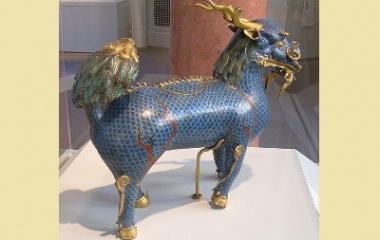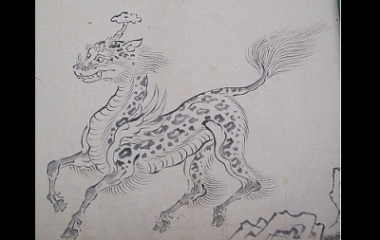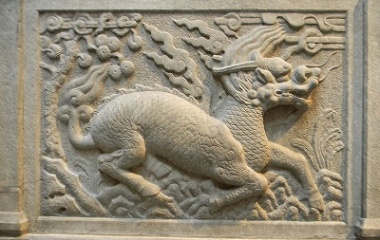What is a Qilin?
A Qilin is a heavenly creature who embodies the virtues of Chinese civilization. He also protects these virtues on earth, using his magical powers to uplift good men wherever he finds them.
Characteristics
Physical Description
Qilin are extraordinarily beautiful creatures, sparkling like gems and adorned in flames. With their scaly bodies and horned heads, they resemble Chinese dragons, but their legs terminate in delicate hooves, rather than the dragon’s vicious paws, and their tails are lion-like instead of serpentine.
No two Qilin look exactly the same. They each have their own, unique embellishments: carp whiskers, plumes of feathers, branched antlers, scales made of precious metals, fiery manes, unicorn-like horns. Whatever their special attraction, they always move gracefully and dazzle the mortals who see them.
Special Abilities
Qilin are noble creatures who mingle with the gods in heaven. When they descend to earth, their pure spirits have a remarkable effect on the world around them.
First, these heavenly creatures are always capable of distinguishing between good men and evildoers. Naturally, they choose to associate only with the best of men, the kindest rulers and the wisest sages. They guard the homes of these elite, reward their good deeds with rich blessings, and fill their hearts with happiness.
Second, they have the gift of prophecy. Although they rarely come right out and state their predictions, they are powerful omens of good fortune. If you see one of these beautiful creatures, you can be sure that you will soon experience a windfall of good luck or that you will meet one of the great men they accompany.
Third, the creatures can provide transportation to and from heaven. They have carried many of China’s greatest heroes, while they were still newborn babies, from heaven down to earth and their destiny. Likewise, they can escort the souls of noble men back to heaven after they die.
Finally, in rare cases, they might attack evildoers. Given their gentle nature, they will only attack if they sense an immediate threat towards an innocent person. When they do attack, fire is their weapon of choice; flames surge from their nose and mouth, incinerating the miscreant on the spot.
Buddhist lore adds an extra quirk to their powers. Because of their extreme gentleness, they are afraid to walk on the grass, lest they injure an innocent blade. To protect the grass, they conjure up small clouds or fountains of water and float just above the ground, instead of taking the risk of trampling a life.
Related Creatures
Qilin are classified as one of the “Four Benevolent Animals” in Chinese folklore. Each of these animals is considered the lord of a group of other species. The Qilin is lord of furred quadrupeds; the dragon is lord of reptiles; the turtle is lord of shelled animals; and the phoenix is lord of birds.
During the Ming dynasty of the 14th century AD, a voyage was made to east Africa, and the explorers returned with a pair of giraffes. The legendary Qilin was immediately tied to the giraffes, who Chinese people heralded as heavenly beings. The giraffes, in turn, gradually influenced the legendary animal. The giraffe’s quiet nature, vegetarian diet, and striking ability to walk across the grass without leaving footprints were all given to the Qilin. In Korea and Japan, the two creatures are even called by the same name to this day.
In Western culture, Qilins are called “the Chinese Unicorn.” Indeed, there are many similarities between the two beings. They are both described as pure, gentle spirits, who only reveal themselves to similarly blameless humans. What’s more, they both have dainty hooves and, sometimes, a single, beautiful horn.
Cultural Representation
Origin
The wonderful Qilin was born out of Chinese mythology. It’s uncertain how long this chimera was loved by Chinese people before it made his debut in the written record, in a 5th century BC narrative called Zhuo Zhan. Over the next few centuries, it continued to gain popularity, being handed down from dynasty to dynasty as a symbol of morality and prosperity. Like many other elements of Chinese culture, the Qilin was also adopted by Korea, Thailand, Vietnam, and Japan.
Famous Myths
The Qilin, along with the dragon, the tortoise, and the phoenix, had free reign of the gardens of the Yellow Emperor, who is considered the father of Chinese civilization and the ancestor of all Chinese people. The creature’s presence in this magical garden symbolizes both how ancient he is and how noble the Yellow Emperor is.
Later, the Qilins decided to grace Chinese civilization with a priceless gift. The emperor at the time was sitting beside the Yellow River, gazing into its dirty water. Suddenly, a wondrous, hooved creature appeared and touched the water, transforming it a delicious shade of clear, bright green. The emperor was stricken with joy, but the good creature wasn’t done with his gifts. He stomped on a rock, calling the emperor’s attention back to himself, then turned to reveal a set of magical symbols shining across his scales. These symbols laid the foundation for China’s first written language.
Still later, a Qilin is reported to have appeared just before the birth of Confucius. In this case, the magical beast broke its usual silence by giving a scroll, made of jade, to Confucius’ parents. The scroll declared that the child would have all the virtues of an emperor and urged his parents to nurture him carefully.
Modern Usage
Today, the Qilin is still revered as a lucky omen and a powerful guardian, so it has become a darling of the home décor industry. Countless statues and paintings of these gentle beasts are manufactured and sold to Chinese people who want to bring its ancient magic to their homes. They are especially popular with practitioners of Feng Shui, who use them both for their traditional benefits and as a symbol of the fire element, which can balance out other elements in the home.
They are also a popular source of inspiration for ritual dances. Because they are associated with heaven and the gods, dancers who succeed at mimicking them can bring great prosperity to their communities.










